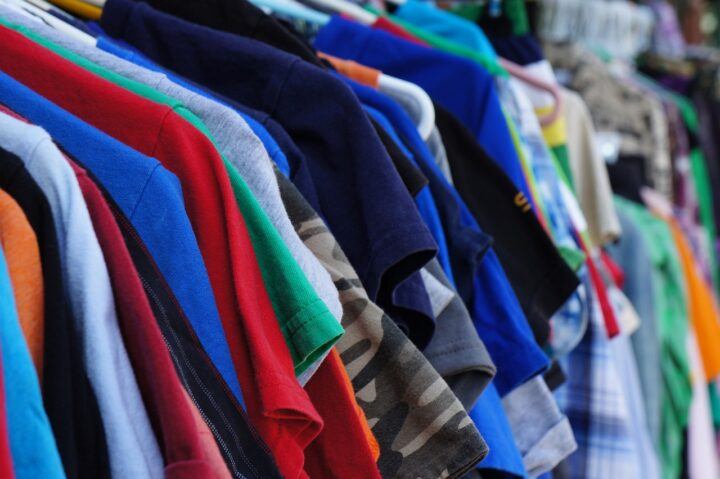Table of Contents
Benefits of Buying Second Hand Clothes: Save Money and the Planet
Ever think about how buying second-hand clothes impacts more than just your wallet? The benefits of buying second-hand clothes helps the environment by reducing waste and saving resources. It’s a way to promote sustainable fashion and cut down on pollution caused by fast fashion.

Besides being eco-friendly, thrift shopping can save you a ton of money. You can find high-quality, stylish garments for a fraction of the price you’d pay for new ones. This is especially great if you’re looking to update your wardrobe without breaking the bank.
Choosing second-hand clothes also allows you to express your unique style. Thrift stores and online resale platforms offer a wide range of one-of-a-kind items you won’t find in regular stores. This makes it easier for you to stand out and put together outfits that truly reflect your personality.
Key Takeaways
- Second-hand shopping helps the environment and reduces waste
- Thrift shopping saves money and offers unique fashion choices
- Choosing used clothes supports sustainable fashion policies
Positive Environmental Impact
Thrift shopping and buying second-hand clothes help reduce the strain on the environment by minimizing waste and conserving resources. These practices support sustainable living and challenge the fast fashion industry.
Combating Fast Fashion
Fast fashion is notorious for promoting wasteful consumption and exploiting natural resources. By choosing second-hand clothes, you disrupt this harmful cycle. You avoid contributing to the demand for new clothing, which often involves excessive use of water, pesticides, and oil.
When you shop for second-hand clothes, you’re essentially recycling. This reduces the need for new manufacturing, lessening the burden on the planet’s ecosystems. Additionally, it helps lower greenhouse gas emissions typically associated with producing new garments.
Reducing Waste and Landfill Strain
Every second-hand item you buy is one less item that ends up in a landfill. The fashion industry generates a considerable amount of waste, much of which is not biodegradable. Clothes made from synthetic materials like polyester can take hundreds of years to break down.
Buying used clothes promotes sustainability by extending the life of garments. It also reduces the overall waste that contributes to landfill overflow. Items that would have otherwise contributed to pollution are given new life when you purchase them second-hand.
Conserving Resources and Energy
Manufacturing new clothing requires vast amounts of resources, such as water and energy. The process also contributes to water pollution and high water footprints. Natural fibers like organic cotton and linen are less taxing on the environment but still require significant resources to grow and process.
By buying second-hand, you help conserve these precious resources. You reduce the energy needed for manufacturing new items and limit water usage associated with producing new textiles. This eco-friendly choice has a meaningful impact on promoting sustainable practices and conserving natural resources.
Economic Benefits for Consumers

Buying second-hand clothes offers significant economic benefits, including saving money on your wardrobe and bolstering local and global economies. You can find items at much lower prices compared to new ones while also benefiting communities and markets.
Saving Money on Apparel
Thrift stores offer a great way to save money on clothes. By buying used clothes, you can get high-quality items at much lower prices. Imagine finding a luxury brand jacket for a fraction of its original cost.
Not only are you paying less, but these clothes often last just as long as new ones. Your wallet will thank you, especially when you realize you can get more items for the same amount you’d spend on one new product.
For cost-sensitive periods like back-to-school or holiday shopping, thrift stores provide an affordable option. Parents often find it beneficial when shopping for kids who outgrow clothes quickly. This way, you can keep up with growth spurts without draining your finances.
Supporting Local and Global Economies
Buying second-hand also helps local economies. When you shop at thrift stores or local consignment shops, the money you spend stays within the community. This helps small businesses thrive and create more jobs locally.
On a global scale, opting for used clothes can reduce demand for fast fashion, which often involves exploitative labor practices. You’re contributing to a movement that promotes fair wages and safer working conditions.
By choosing second-hand, you support a sustainable fashion industry. This has a ripple effect, benefiting both the environment and economies around the world. Every time you buy used clothing, you’re making a responsible choice that reaches far beyond just saving money.
Unique Fashion and Individuality
Shopping for second-hand clothes can be an exciting adventure. You can find truly unique pieces that reflect your personal style and stand out from the crowd while also supporting sustainable fashion.
Finding Unique Treasures
One of the best parts of thrifting is discovering one-of-a-kind pieces that you can’t find anywhere else. Many second-hand stores stock vintage items and high-quality clothes with unique designs. These treasures may no longer be in production, making them rare finds. This helps you build a wardrobe that is distinctive and personal. Whether you’re looking for a retro jacket or a quirky accessory, the thrill of the hunt is part of the fun and assures that what you find is uniquely yours.
Making Personal Fashion Statements
Buying second-hand clothes allows you to make a personal fashion statement. Since the items are not from current fashion trends, you can mix and match pieces to create a look that’s completely your own. You can dress to express your individuality without being limited to what’s currently in style at big retail stores. This creative freedom ensures that your fashion statement is always fresh and unique. When you wear second-hand clothes, you’re not just wearing something; you’re telling a story. Each piece has a history, and incorporating it into your wardrobe adds depth to your personal style.
Promoting Diversity in Clothing Choices
Second-hand shopping promotes diversity in clothing choices. Mainstream stores often carry similar styles and trends, leading everyone to dress somewhat similarly. By turning to second-hand stores, you can find a wider variety of clothes from various eras and designers. This ensures a more diverse and interesting wardrobe. Different cultures, time periods, and styles blend together to create a rich tapestry of fashion diversity. By embracing second-hand clothes, you support a fashion ecosystem that values variety and creativity over mass production and uniformity.
Social and Ethical Considerations
Buying second-hand clothes offers various social and ethical benefits, touching on issues like supporting charitable causes and addressing ethical problems in the fashion industry. Here’s a closer look at how these aspects come into play.
Contributing to Benefits for Charity
When you shop at charity shops, you are directly helping various non-profits and good causes. These shops often funnel their earnings into helping people in poverty or supporting community projects. The money you spend goes to those in need, creating a positive change.
Thrifting also emphasizes quality over quantity, encouraging you to choose well-made items that can last longer. This approach reduces overconsumption and helps you to develop a more mindful attitude toward reuse. Engaging in this practice can feel like treasure hunting, finding unique items while also giving back to society.
Pact and other sustainable brands advocate for buying second-hand as a way to support the circular fashion economy, benefiting both the environment and social causes.
Challenging Ethical Issues in Fashion Industry
The fashion industry is often criticized for labor exploitation and unethical practices. Buying second-hand clothes can be a form of protest against these issues. By choosing thrifted items, you are opting out of supporting fast fashion brands that may exploit workers.
This shift promotes circular fashion, where garments are reused instead of being discarded. You’ll be contributing less to the need for new manufacturing, reducing the demand for unethical labor practices.
Additionally, when you buy second-hand clothing, you also make a statement against the giants of fast fashion. This drives more attention to sustainable brands and their commitment to ethical manufacturing.
By being mindful of where and how you shop, you can help spur positive change in the industry, pushing it towards more ethical practices.
Durability and Quality of Second-Hand Garments
Second-hand clothing offers impressive durability and quality, often surpassing new, fast-fashion items. Many second-hand goods come from high-quality brands, crafted with care and designed to last.
Assessing Quality in Second-Hand Markets
When shopping for second-hand garments, quality is key. Check seams and stitching for sturdiness. High-quality garments usually have reinforced seams and no loose threads.
Examine fabrics closely. Natural fibers like cotton, wool, and silk often last longer. Check for any signs of wear or damage, such as holes or stains, which can affect durability.
Many second-hand stores sort items by condition. Use this feature to find the best pieces. Don’t hesitate to ask store staff for advice on spotting high-quality items.
The Value of Well-Made Second-Hand Goods
Well-made second-hand goods offer exceptional value. Items from established brands tend to last longer, maintaining their appearance and function over time. This durability makes second-hand clothing a smart buy, giving you quality pieces at lower prices.
Many second-hand treasures include unique pieces like vintage handbags or custom-made garments. These special finds add character to your wardrobe, making your style truly yours.
Buying second-hand supports sustainable fashion. By giving garments a second life, you help reduce waste and lessen the fashion industry’s environmental impact. Plus, shopping locally supports your community and small businesses, creating a positive ripple effect.
Check out articles like this one to learn more about how second-hand clothing benefits the environment and your wallet.
How Shopping Second-Hand Supports Sustainability
Buying second-hand clothing can significantly impact the environment. It supports sustainable practices by reducing waste, conserving resources, and lowering demand for new production.
Encouraging the Circular Economy
When you buy second-hand, you help promote the circular economy. This means that clothes are reused and recycled, rather than thrown away. This cycle helps reduce textile waste and keeps clothes out of landfills.
By participating, you are actively slowing down the throwaway culture. Items that could end up as waste get a new lease on life. This reduces the need to produce new clothes, which saves resources and energy.
Minimizing the Need for New Production
Second-hand shopping decreases the demand for new clothing production. Making new clothes uses a lot of natural resources like water and raw materials like cotton. It also involves processes that can pollute air and water.
By choosing used clothes, you directly cut down on the pollution and resource consumption tied to creating new clothes. This is a simple yet effective way to lower your environmental footprint.
Upcycling and Creative Reuse of Clothing
Upcycling is taking old clothes and giving them a new purpose. This could mean making alterations to fit better or turning an old item into something new. You can be creative and give clothes a new life.
This practice not only reduces waste but also saves money. Upcycling encourages using what you already have rather than buying new. This makes it a fun and eco-friendly activity that supports sustainability.
Reducing the Demand for Fast Fashion
Fast fashion is all about making a lot of clothes quickly and cheaply. This leads to poor working conditions and massive waste. Buying second-hand reduces the demand for fast fashion, helping to curb its negative effects.
When you choose sustainable second-hand clothes, you send a message to brands that conscious choices matter. This can push brands to adopt more sustainable practices, benefiting both people and the planet.
Platforms for Second-Hand Clothes
When buying second-hand clothes, you can explore both local thrift stores and online platforms. Each option offers a unique way to score great deals and help the environment.
Local Thrift Stores Versus Online Options
Local thrift stores are great for hands-on shopping. You can feel the fabric, check the quality, and try items on before buying. Stores like Goodwill and consignment shops often organize clothes by size, making it easy to find what you need. There’s a sense of community, and sales can support local charities.
Online options offer a wider variety. Platforms like Poshmark and eBay give you access to items from all over the world. These sites usually have user reviews, so you can read about other buyers’ experiences. Online thrift stores and Craigslist are easy to navigate and allow for protected payments, making your transactions safer.
E-commerce Opportunities in Second-Hand Fashion
Online resale platforms have created a booming marketplace. Poshmark and eBay are popular choices, with millions of users and items. These platforms let you sell anything from clothes to home decor, making it a flexible way to earn money.
Poshmark is especially user-friendly, offering up to 70% off on popular brands. Payments are protected, so you can shop without worry. Etsy also has a market for vintage clothing, where you can find unique, high-quality items.
On platforms like Craigslist, you can find local sellers for a more personal exchange. The ability to sell or buy locally reduces shipping emissions, making it an eco-friendly option. Each of these e-commerce sites offers its own set of benefits, giving you multiple ways to engage in second-hand fashion.
Frequently Asked Questions
Buying second-hand clothes offers plenty of perks for your style and wallet. It even has some major positive impacts on the planet. Curious? Let’s break it down.
What are the perks of snagging clothes from a thrift shop?
Thrift shops are like hidden treasure troves. You can find unique pieces that no one else has. Plus, it’s usually way cheaper than buying brand new stuff. You can score high-quality clothes at budget-friendly prices and even find vintage gems that aren’t available anywhere else.
Can scoring pre-loved threads help out the planet?
Yes, buying second-hand is a big win for the environment. It reduces the demand for new clothing production, which means less water and energy use. Plus, it cuts down on waste, keeping more clothes out of landfills. So, you’re basically giving the planet a high-five.
What’s the real deal with the pros and cons of thrifting?
On the plus side, thrifting saves money and gives you a unique style. It’s also eco-friendly. On the downside, it can take time to find the perfect item, and sometimes the clothes may show signs of wear. But overall, the benefits often outweigh the drawbacks.
How does getting gear second-hand affect the environment?
Second-hand shopping reduces the need for new clothes to be made, which helps lower the strain on natural resources. It also decreases the pollution caused by manufacturing processes and the carbon footprint tied to transporting new goods. Basically, less new stuff means less environmental harm.
Why are peeps into the whole thrifting scene these days?
People love thrifting for its mix of fashion and sustainability. It’s seen as cool to have a unique style that doesn’t come from a big chain store. Plus, there’s a satisfaction in finding a great deal and knowing you’re doing something good for the planet.
Are there any downsides to bagging second-hand clothing?
Thrift shopping can be hit or miss. You might not always find what you’re looking for, and some items could have damage or stains. There’s also the time factor; it can take a while to sift through everything. But if you’re up for the hunt, it can be totally worth it.

